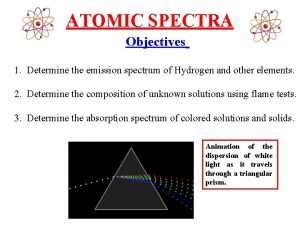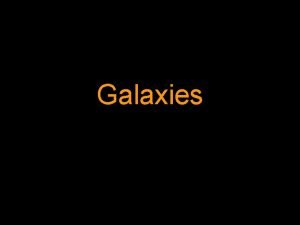Hydrogen 21 cm Emission from Galaxies at Redshifts

- Slides: 1

Hydrogen 21 -cm Emission from Galaxies at Redshifts 0. 24 & 0. 37 Philip Lah 1, Jayaram Chengalur 2, Michael Pracy 1, Frank Briggs 1, Matthew Colless 3 & Roberto De Propris 4 1 Australian National University, Australia, 2 National Centre for Radio Astrophysics, India, 3 Anglo-Australian Observatory, Australia, 4 Cerro Tololo Inter-American Observatory, Chile Introduction l the rate of star formation in galaxies has dropped by a factor of ten in the last 9 billion years (since redshift z = 1. 0) l however the neutral hydrogen gas content of galaxies - the fuel supply for star-formation - is only poorly constrained by observations over this period of time l using deep radio observations with the Giant Metrewave Radio Telescope (GMRT) we have been making the first radio measurements of the neutral hydrogen gas content of galaxies during this cosmologically interesting period of the universe l the gas in galaxies can be quantified using radio observations of the 21 -cm (1420 MHz) emission line from the hyperfine transition in the electronic ground state of neutral atomic hydrogen (HI) l however as one goes out to greater distances (and hence further back in time) the strength of the hydrogen 21 -cm signal becomes increasingly fainter and more difficult to detect with current radio telescopes l to overcome this we coadded the HI emission signal from many galaxies locating them in the radio data using their optical position and redshift to measure the mean neutral hydrogen gas content of the galaxies l optical redshifts were obtained for the galaxies using the Anglo Australian Telescope (AAT) Coadded HI Spectrum for Galaxies at z=0. 24 raw Star Forming Galaxies at Redshift z = 0. 24 Galaxy Cluster Abell 370 at Redshift z = 0. 37 Cluster Center of Abell 370 (VLT image) l the galaxies considered are within a projected distance of ~7 Mpc of the large galaxy cluster Abell 370 at a redshift z = 0. 37 (a look-back time of 4. 0 billion years) l Abell 370 was observed with the GMRT for 34 hours at a frequency of 1036 MHz l the measured average atomic neutral hydrogen mass of all the 324 galaxies around the galaxy cluster was (6. 6 3. 5) 109 solar masses. These galaxies include all morphological types. l the 92 optically blue galaxies that lie outside the X-ray emitting, ionised intracluster gas of the cluster core have measured average atomic neutral hydrogen mass of (23. 0 7. 7) 109 solar masses l Abell 370 has around 5 to 10 times as much HI gas as Coma, a nearby galaxy cluster of similar size, showing evidence for the evolution of HI gas in clusters over the last 4 billion years l Abell 370 shows a similar trend to nearby clusters, in that galaxies close to the cluster centre have less HI gas For further information see: Lah et al. 2007, MNRAS, 376, 1357 and Lah et al. 2008, MNRAS, in preparation l the panels below and to the left show the coadded HI spectrum for the galaxies in Abell 370. The top panel is for all 324 galaxies and the bottom panel is for the 94 blue galaxies outside of the X-ray emitting, ionised intracluster gas of the cluster core. l the panels below and to the right show the coadded HI image for the galaxies in Abell 370 windowed in velocity. The top panel is for all 324 galaxies using a synthesised beam size of 5. 8 arcseconds. The bottom panel is for the 94 blue galaxies outside the X-ray gas using a synthesised beam size of 9. 7 arcseconds. Coadded HI Spectrum for All Galaxies in Abell 370 Coadded HI Image for All Galaxies in Abell 370 raw l the galaxies were selected from optical narrow band filter observations with the Japanese Subaru Telescope for emission in the Hα line at redshift z = 0. 24 (look-back time of 2. 8 billion years) (Fujita et al. 2003, Ap. J, 586, L 115) binned l the top figure to left shows the coadded HI 21 -cm emission spectrum from 121 galaxies using 44 hours of GMRT integration time on the field at a frequency of 1145 MHz l the measured average atomic neutral hydrogen mass of the 121 galaxies was (2. 26 0. 90) 109 solar masses (M* at z 0 is 6. 3 109 solar masses) Cosmic HI Gas Density l the bottom figure to the left shows the neutral gas density of the universe as a function of look-back time l the small, black triangle at z = 0 is the HIPASS 21 -cm emission measurement from Zwaan et al. 2005, MNRAS, 359, L 30. The blue, open circles are damped Lyα measurements made in the ultraviolet by Rao et al. 2006, Ap. J, 636, 610. The red, filled circles are damped Lyα measurements made in the optical from Prochaska et al. 2005, Ap. J, 635, 123. l the large, black triangle at z = 0. 24 is our HI 21 -cm emission measurement, (9. 5 4. 4) 107 solar masses per Mpc 3. Our value is consistent with that from damped Lyα at similar redshifts but has the advantage of being over a much narrower redshift/look-back time range. Coadded HI Spectrum for Blue Galaxies Outside X-ray raw binned Coadded HI Image for the Blue Galaxies Outside the X-ray Gas

